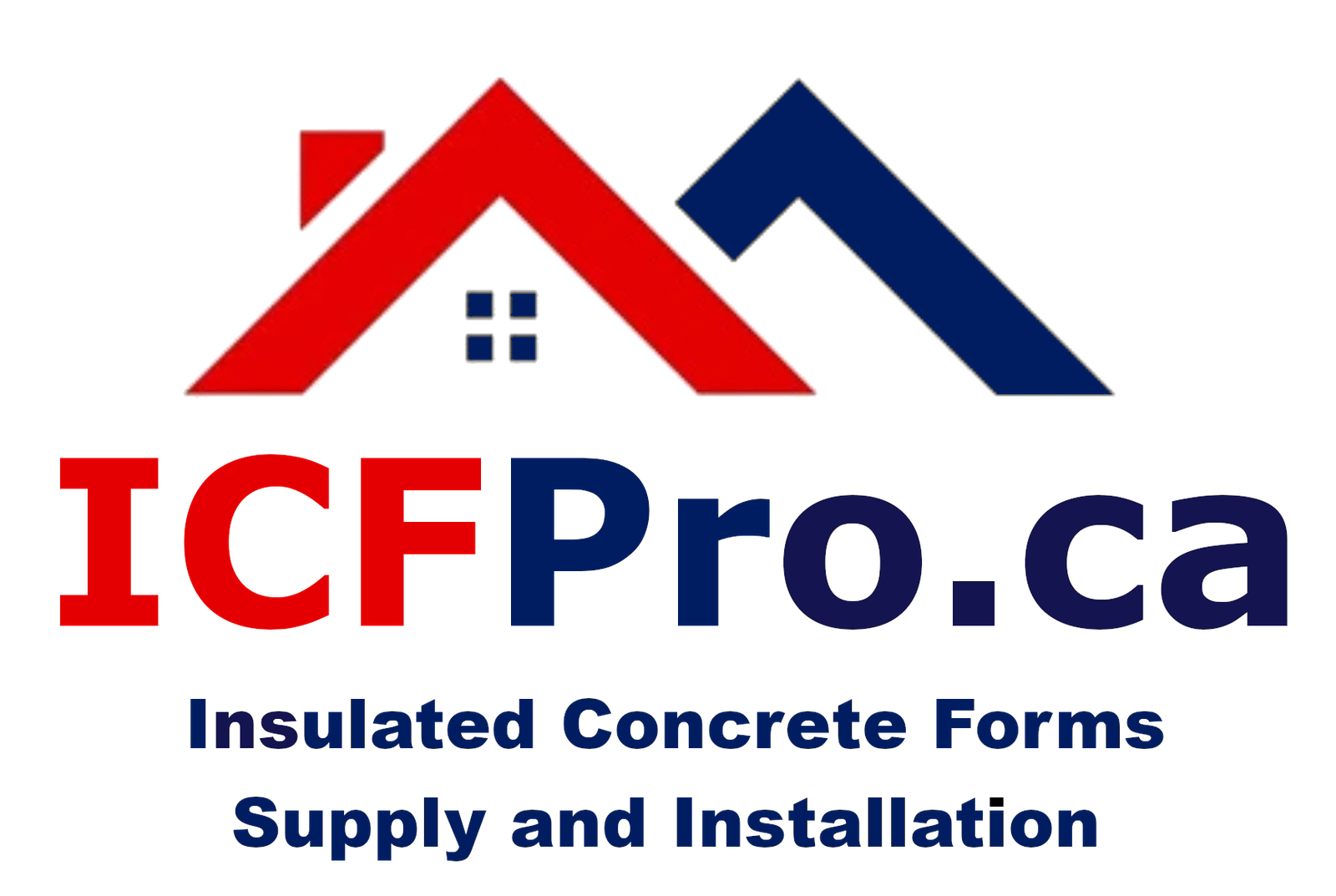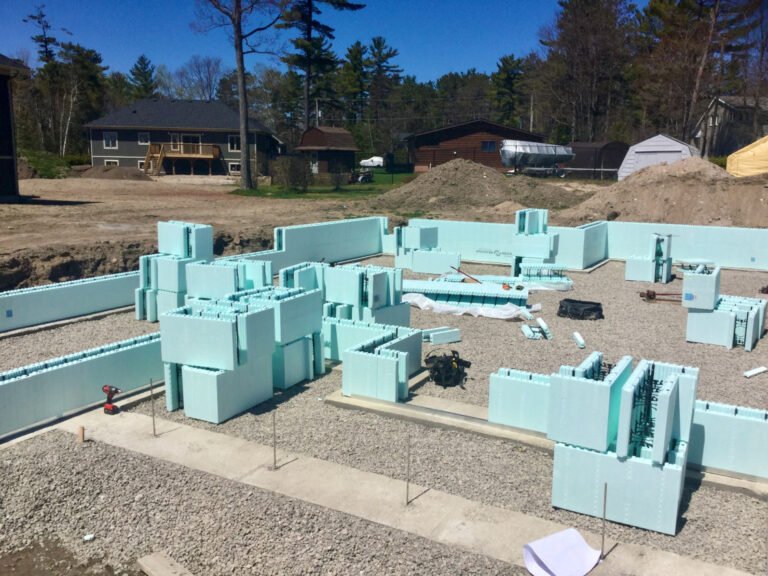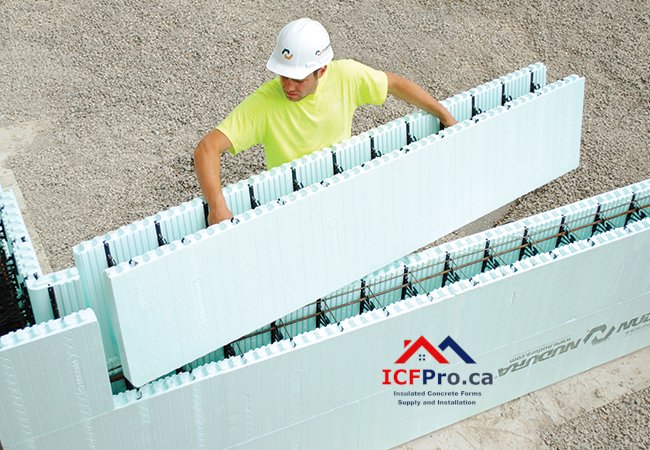ICFPro.ca is a division of ICFhome.ca - Phone 1 866 868-6606 - Direct Line 1 705 533-1633 - Email: info@icfhome.ca
ICF Lot Grading

ICF Lot Grading: The Invisible Force Field Protecting Your Foam-and-Concrete Fortress
Imagine building a castle with walls so strong they laugh at hurricanes, only to have it collapse because you forgot to divert a puddle. That’s the irony of ICF construction: Even the most robust Insulated Concrete Form structure can fail if its lot grading isn’t engineered like a Swiss watch. Proper ICF lot grading isn’t just about moving dirt—it’s about creating a hydrological masterpiece that keeps water far from your foundation. Let’s break down the science, the stakes, and the secrets to getting it right.
1. The Art of Slope: Grading Guidelines for ICF Perfection
ICF lot grading is a Goldilocks game—too steep, and you risk erosion; too flat, and you’re hosting a basement pool party.
A. The Slope Sweet Spot
- Grassed Areas: 2% to 7% slope (2–7 cm drop per meter).
- Why? Steeper than 7% erodes soil; flatter than 2% pools water.
- Pro Tip: Use laser levels, not eyeballs. A 1% error = 500 gallons of water against your foundation annually.
- Terraced Slopes: For grades >7%, build 3:1 terraces (3 units horizontal to 1 vertical).
- Case Study: A Colorado hillside home used terraced ICF grading to survive 8” of rain in 24 hours—zero flooding.
B. Driveway Dynamics
- Max 6% slope from curb to garage.
- Why? Steeper grades hydroplane cars and funnel water toward the house.
- Fix: Install trench drains at the base to intercept runoff.
C. Foundation Elevation
- 150 mm Rule: Keep finished grade 6” below the top of the ICF wall.
- No exceptions—burying foam invites pests and moisture wicking.
2. Drainage Systems: The Underground Plumbing Your ICF Foundation Craves
Water is lazy—it takes the path of least resistance. Your job? Make that path lead away from your basement.
A. Perimeter Drains
- Location: Below footing level, wrapped in geotextile fabric.
- Gravel Bed: 12” of ¾” clean stone around drain tile (no fines!).
- Why? Fines clog pipes; clean stone maximizes flow.
B. French Drains 2.0
- Slope: 1% minimum (1 cm drop per meter).
- Pipe Size: 4” PVC with sock filter (prevents root intrusion).
- Pro Move: Add an overflow outlet every 15’ for heavy rains.
C. Dimple Board Defense
- Material: High-density polyethylene (HDPE) panels.
- Function: Creates an air gap between soil and waterproofing, reducing hydrostatic pressure by 70%.
- Install Tip: Overlap seams 6” and seal with butyl tape.
3. Waterproofing: The Force Field for Your ICF Walls
ICF’s foam insulation is not a waterproofing substitute. Here’s how to seal the deal:
A. Self-Adhered Membranes
- Brands: Grace Ice & Water Shield, Tremco Tuff-N-Dry.
- Application:
- Clean walls with denatured alcohol.
- Heat membrane with propane torch for 2” overlaps.
- Roll seams with a 50-lb roller.
- No-No’s: Cold application (fails below 50°F) or skipping primer.
B. Fluid-Applied Systems
- Best For: Complex shapes (window wells, pipe penetrations).
- Cure Time: 24–48 hours (humidity-dependent).
C. Basement Buoyancy
- High Water Table Fixes:
- Ballast Slabs: 8” thick concrete floors weighted with rebar.
- Dewatering Systems: Permanent sump pumps with battery backups.
Data Point: A 2023 study found 92% of flooded ICF basements had inadequate waterproofing vs. proper drainage.
4. Soil Science: How Dirt Dictates Drainage
Your soil type is the unsung hero—or villain—of ICF lot grading.
A. Soil Types & Solutions
| Soil Type | Drainage Risk | Fix |
|---|---|---|
| Clay | Poor drainage 🚱 | 24” gravel beds + deep French drains |
| Sand | Over-drains 💨 | Compacted base + silt fences |
| Loam | Goldilocks zone ✅ | Standard grading |
B. Cutoff Walls
- When? High-permeability soils (sand/gravel) with groundwater flow.
- How? Install sheet pile or slurry walls 2–3’ below footing.
Case Study: A Vancouver home on sandy soil used a bentonite slurry wall to reduce groundwater inflow by 80%.
5. Documentation: The Paper Trail That Saves Your Bacon
ICF lot grading isn’t just dirt work—it’s a legal safeguard.
A. Grading Plan Essentials
- Existing vs. Proposed: Show elevation changes at 10’ intervals.
- Spot Elevations: Mark swales, drains, and foundation corners.
- Slope Arrows: Indicate flow direction (away from the house!).
B. Lot Grading Certificates
- Who Signs: Professional engineer or surveyor.
- Timeline: Submit pre-construction and post-final grade.
Red Flag: Skipping certs voids 70% of builder warranties.
6. The Cost of Cutting Corners: Consequences of Poor Grading
ICF’s Achilles’ heel? Assuming foam and concrete make you invincible.
A. Moisture Mishaps
- Efflorescence: White salt deposits on walls (harmless but ugly).
- Spalling: Concrete degradation from freeze-thaw cycles.
B. Structural Stress
- Hydrostatic Pressure: 1 psi per 2.31’ of water depth—enough to crack unbraced walls.
C. Energy Loss
- Wet Insulation: Reduces R-value by 50% (per Oak Ridge National Lab).
Real-World Horror: A Texas homeowner ignored grading—their 400kICFhomeneeded400kICFhomeneeded75k in mold remediation after one rainy season.
7. The Future of ICF Lot Grading: Smarter, Greener, Stronger
- AI Grading Plans: Tools like Civil 3D auto-calculate slopes and drainage.
- Permeable Pavers: Integrate with ICF driveways to reduce runoff.
- Smart Drains: IoT-connected sensors alert phones to clogs or overflows.
Prediction: By 2030, 40% of ICF projects will use AI-optimized grading.
Conclusion: Grading Isn’t Grading—It’s Guardian Angels
ICF lot grading isn’t about moving dirt. It’s about engineering an invisible shield that deflects water, preserves your foundation, and keeps your basement drier than a British comedy. Yes, it adds 5–10% to your budget. But in a world where 90% of basement failures trace back to poor drainage, it’s the ultimate insurance policy.
Final Word: Build your ICF home like you’re defending against a water invasion—because you are.



